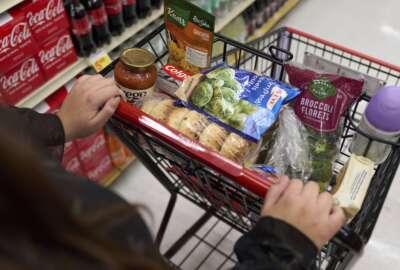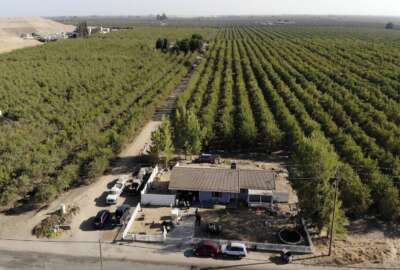Hubbard Radio Washington DC, LLC. All rights reserved. This website is not intended for users located within the European Economic Area.
On Air: Federal News Network
Trending:
July, the time for weenies and pretzels and beer, and for USDA, feeding the hungry
The annual Feds Feed Families campaign has raised nearly 100 million pounds of food since 2009. The 2023 campaign, just a few weeks in, has the goal of gatherin...
The annual Feds Feed Families campaign has raised nearly 100 million pounds of food since 2009. The 2023 campaign, just a few weeks in, has the goal of gathering more than eight million pounds of food this year. For an update and how you can help, Federal Drive with Tom Temin talked with Feds Feed Families National Chairwoman, Andrea Simao and the Acting Deputy Assistant Agriculture Secretary for Administration, Duane Williams.
Interview Transcript:
Tom Temin Let’s begin with the overall outline of the Fed’s Feed Families program. This has been going a number of years now, and what families do we hope to feed here?
Duane Williams We’re very excited to yet again lead this campaign, the Fed’s Feed Families campaign for 2023. United States Department of Agriculture, we are committed to feeding people in this country. The Fed’s Feed Families campaign, as you mentioned, started back in 2009 as an opportunity for the federal workforce to be able to give back an in-kind contribution and particularly into food. We also take time and whatever support that you can give to the food banks in your local area. The idea is that here’s what we do know, is that while we’ve made a significant impact, Tom, as you mentioned, over 107 million pounds that we’ve collected over the last 14 years, the need is still there. More than 33 million families are suffering from food insecurity in this country, as we stand here today. And so with all of that said, this is our opportunity. The federal workforce, who never, by the way, ceases me with their generosity and what they can do in helping to bridge this gap, as many of us are aware, the food banks during the summer months, the cupboards are bare, the cupboards are bare and we need them more than ever during the summer months. Why is that so? Well, mostly because many of our school aged kids who depend on healthy foods through the National School Lunch Program, also managed by the Department of Agriculture, those foods are not available for them during the summer months. We have families who are working and really struggling to make ends meet, and we know that because of what’s happening at the food bank. And so right now we’re just excited about another opportunity of the federal workforce to be able to step in and fit it and continue to make a difference in the lives of the American people.
Tom Temin All right. And Andrea, are you looking for donated food items or really cash contributions so that the food banks can use their buying power to get what they feel they need?
Andrea Simao Well, Tom, thank you. There are actually five different ways that a person, an employee can contribute to the Feds Feed Families. One, of course, is by donating food to a local food bank or pantry in their area. Another way is to donate through a financial donation to, again, a food bank in their local area. They can also participate by contributing if they’re a gardener, contributing food from their garden to a food bank in their area. So and then they can also participate in gleaning events. And we invite everyone to visit the Feds Feed Families website so they can look for new opportunities to contribute through and donate through the Feds Feed Families Campaign.
Tom Temin And just a quick follow up on gleaning events. That is, you can glean a field where we’re instructed by the great book not to glean the corners of your fields. Leave that for the poor. So this is to do that gleaning for the poor. How does that work?
Andrea Simao That’s exactly how it would work. You would go to a producer that is interested in participating in Feds Feed Families, and then work with that producer, that farmer to harvest products that can then be dropped off at a local food bank. You can also glean at a food bank itself by helping to repackage donated food and package up boxes for families to collect. And we have more information on gleaning activities as guidelines on our website. Feds Feed Families.
Tom Temin And this is a national effort, I’m presuming. And let me ask you this. I mean, in some areas that are highly populated, like the counties around Washington, they have large, elaborate, easily accessible food banks. What about the rural areas or some of the tougher urban areas in the country where there’s not even a grocery store, sometimes, that’s great in those areas, let alone a food bank. How do you deal with the people that are little harder to reach?
Duane Williams At the United States Department of Agriculture, we have more than 4500 offices around the country. And with that being said, all of our employees, just at USDA alone, and that’s not counting – because this is the national food drive – that’s not counting all of the offices amount of federal agencies in this country. But just in USDA alone, 4500 offices around the country and all of our employees are participating in this event. So here’s what we intend to do. We intend to work with our employees, as we’ve done in the past, and have them to identify food banks of their sorts in the local area. And the food that they collected, those offices, those food are then transported to those local food banks. And so the goal, as you mentioned, is to reach every food bank in this country so that we can continue to make the impact that we’ve made so far over the last 14 years.
Tom Temin We’re speaking with Duane Williams. He’s deputy assistant secretary for administration at the Agriculture Department, and Andrea Simao, national chair of the Feds Feed Families Program. And what types of food, if you’re going to donate food, are you really looking for? I mean, like a whole case of Wonder Bread might not be ideal if you can get something a little bit more nutritious and calorie packed.
Andrea Simao Well, we would encourage everyone to work with their local area food banks and pantries to see what are the most requested items that they need so that we can provide an immediate impact and assistance to the families in that area. But obviously, we are looking, as you mentioned, for healthy food, nutritious food, diverse food as well, because we have a very diverse population in the United States. So we encourage everyone to check with their local food banks to see what is really needed at this time.
Tom Temin And what kind of corporate, if any, or say, community support at the nonfederal level do you get for Feds Feed Families?
Andrea Simao We work very closely with food banks and shelters and pantries around the country, particularly here in the in the Washington, D.C. area. We work with the Capital Area Food Bank so others might eat. And there’s also a nationwide group called AmpleHarvest.org. And this is where you can look for food banks that accept produce from local gardens. And this way we are able to again, provide that immediate assistance and support to those who may need it.
Tom Temin And Duane?
Duane Williams Because of the way this campaign is structured, many of the families that work at the USDA and throughout the federal workforce, many of their relatives are non federal employees. And so I do want to point out that this this drive in this campaign is being led by the federal workforce, is not designated for just the federal workforce. So your families and your friends that may be employed anywhere throughout the private industry, it doesn’t matter. What we’re looking to do is have an impact because our goal this year is to fight hunger and to give hope. There’s no better way to do that than to engage with your community in its entirety. And so that’s our goal, to spread this wide and far to ensure that everyone has an opportunity to participate and to make an impact.
Tom Temin And how long does the program run?
Duane Williams The program this year, we started June 26, and we will run through Sept. 30, which is the end of our fiscal year.
Tom Temin Got it. So everyone who is going to get a school lunch, they’ll be in place by then. By the time you’re done, everyone will have had access to those meals that, as you say, disappear in the summer.
Duane Williams I do want to add this, though, and great segue to what I want to say here. Hunger and food insecurity does not end on Sept. 30. They are still in need throughout the year. And so what we’re looking to do is not just end it there, although the federal campaign will end there, there is an opportunity to participate and to make food donations throughout the year.
Andrea Simao Yes, Feds Feed Families is a year-round initiative that the federal government does. We focus on the 3 to 4 months of the summer because that is where we see the need is greatest. And, as Duane mentioned, the food banks and the pantries really need our assistance. But everyone can contribute year round through the Feds Feed Families. And we have a dashboard that you can, when you donate, you can immediately see the impact of your donation by registering and logging your donation on the dashboard. And we are very close. I’m pleased to say we’re very close to having donated 2.5 million pounds since the start of this year. And we’re as Duane mentioned, we’re really hoping to increase that with the help of the federal workforce around the country to more than double that and possibly, in fact, have donations that exceed 8 million pounds.
Tom Temin And there’s a special event coming up next week in this program.
Andrea Simao Yes, next Wednesday, July 19th, is the Feds Feed Families third annual day of giving Stuff the Truck event. And it is the Feds Feed Families Campaign hallmark event. At various locations nationwide, federal employees from different departments and agencies will host or participate in events to pack, stuff, load a truck, car or van with donated food to deliver to area food banks and help others in need. In fact, we know of one Veteran’s Affairs agency which is hosting a stuff the stretcher event. So that’s very fun.
Copyright © 2024 Federal News Network. All rights reserved. This website is not intended for users located within the European Economic Area.
Tom Temin
Tom Temin is host of the Federal Drive and has been providing insight on federal technology and management issues for more than 30 years.
Follow @tteminWFED
Related Stories
USDA modernizes an important research facility with a whole new building
Related Stories
-
USDA modernizes an important research facility with a whole new building Facilities/Construction





